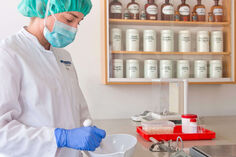History of the pharmacy

The University Hospital in Heidelberg had its beginnings in 1815, when the academic medical hospital with 20 beds was established in the old Dominican monastery. In 1818, the hospital moved to the Marstallhof, where the "Surgical Clinic" and the "Maternity Centre" were founded. When the hospital moved into the newly constructed buildings on the banks of the Neckar in 1876, it had already grown to 400 beds. Within a short space of time, it developed into a large building complex by incorporating all the university clinics, in which the old hospital and the hospital administration are still located today.
When the new hospital was built, the establishment of a pharmacy as a dispensary in the central administration building was taken into account. As no expert advice was sought on the construction of the premises at the time, the pharmacy remained a makeshift solution for decades due to the inadequacy of the rooms.
In 1876, Privy Councillor Friedreich, then Director of the Medical Clinic, commissioned the pharmacist Dr Gustav Vulpius to set up and manage a hospital pharmacy. He had become aware of Vulpius through his numerous publications. The pharmacy was opened in November 1876. Initially, it only supplied the Medical Clinic, Surgery, Eye Clinic, Pathology and Hygiene Institute. This was quickly followed by the Psychiatric Clinic, Women's Clinic, Paediatric Clinic, Dental Clinic, Ear, Nose and Larynx Clinic, the Institute for Experimental Cancer Research with its large infirmary, the Medical Polyclinic and the Skin Clinic. Attached to the pharmacy was also a mineral water factory, where two servants were employed in the production of lemonade, soda water and artificial mineral water. In addition to catering for the academic hospital, the pharmacy also supplied the city's poor, the insured servants and the poorhouses against payment. In addition, the pharmacy increasingly dispensed medicines free of charge to patients who volunteered to teach medical students. It was not until 1903 that the distribution of medicines outside the home was increasingly restricted and finally stopped altogether. Vulpius retired in 1901.
His successor was Dr Franz Weiss, who had previously been the administrator of the institution pharmacy in Emmendingen.
The cramped premises could hardly cope with the ever-increasing demands on the pharmacy. The prescriptions in the hospital, which was growing from year to year, had risen from 25,000 in 1878 to 75,000 in 1900 and 120,000 in 1928. Up until 1924, the drugs used were almost exclusively produced in-house in the formulation and manufacture. Despite the constantly increasing number of new industrially produced remedies, finished medicinal products were hardly used in any of the company's clinics at that time. Weiss was able to achieve a modest increase in the size of the work and storage rooms at the beginning of his period of service and gained additional rooms after the end of the First World War.
However, the 127 m2 now available were still far too modest.
During the First World War, the hospital was converted into an association hospital with mainly surgical cases. During this time, the demands on the pharmacy declined massively due to the closure of almost all laboratories, among other things, so that the work could still be managed despite the call-up of some auxiliary staff. Weiss managed the pharmacy until his retirement in 1933.
Dr Alfred Dorner, who had been an assistant in the hospital pharmacy in Heidelberg since 1912, took over from Weiss despite his left-wing democratic views and many Jewish contacts. When Dorner died after a long illness in 1942, the NSDAP member and former SS man Dr Paul Baumann was put in charge of the pharmacy. Despite his enlistment in the Wehrmacht, Baumann was called to Heidelberg to take over the management of the pharmacy after Dorner's death. In exchange for Baumann, pharmacist Werner Heid was sent to the front. Due to the tense personnel situation during the war, the army provided the pharmacy with army pharmacists as employees. The recruitment of a 60-year-old pharmacist, who had spent 30 years in the tropics, proved to be a failure due to his incompetence and he had to be dismissed after a short time due to his unsustainability. At this time, only one pre-examiner was available from the civilian side.
After the end of National Socialism in 1945, Baumann was dismissed from the hospital pharmacy as part of the denazification process and Hubert Conrad, who had been employed in the hospital pharmacy since 1940, was appointed acting manager. Due to the poor supply situation and the inadequate staffing of the pharmacy with Conrad as the only pharmacist, the hospitals became increasingly dissatisfied with the pharmacy, which was barely able to cope with supplying the 3,000 beds.
In 1948, Mr Werner Heid was appointed pharmacy manager and Conrad remained as assistant. The cramped conditions in the pharmacy, which only had 127 m2 of space on the ground floor and 60 m2 in the basement, and the still poor staffing situation with 2 licenced pharmacists, 3 pre-examiners and 5 assistants, made supplying the hospitals extremely difficult. At the beginning of the 1950s, the pharmacy was rebuilt, extended and modernised. A sterile laboratory was set up, a steriliser for preparing infusions was purchased and a water distillation plant was put into operation. The pharmacy was divided into rooms for tablets, suppositories, liquids, ointments, antibiotics and disinfectants. An infusion store was made available in the basement.
In 1959, Dr Heid, who had meanwhile completed his doctorate in medicine, left to practise as a doctor. The former acting manager, Dr Hubert Conrad, who had also gained a doctorate in medicine in the meantime, became pharmacy manager. During Conrad's time as pharmacy manager, the pharmacy underwent several minor and major remodelling and extensions. In 1967, additional cellar rooms were made available by the administration. In 1972, the sterile department was completely rebuilt, a new steriliser for 240 infusion bottles and a completely new water distillation system were purchased. After a serious illness, Dr Conrad died in 1973.
The new head was the previous deputy head, Dr Richard Wolf. †
Despite several conversions and extensions, the conditions in the pharmacy were still very cramped. In 1979, Dr Wolf arranged for the infusion store to be moved from the pharmacy cellar to the dermatology clinic. The former infusion store became an expedition, where the medicines prepared for the wards were checked again. In 1978, the construction of a medical supply centre was planned, into which the pharmacy was also to be relocated. Construction began in March 1982.
When Dr Wolf retired in 1983, a new director had not yet been appointed. Dr Eugen Schöneberger managed the pharmacy on an interim basis for around 6 months. Then Dr Wolf's former deputy, Mr Günther Schork, took over the temporary management and in November 1984 the full-time management of the pharmacy. Mr Schork and the pharmacy staff were able to move into the new premises at Neuenheimer Feld 670 in 1987. For the first time in the history of the Heidelberg Clinic Pharmacy, the pharmacy no longer had to struggle with cramped premises. The 3,300 square metres now available offer sufficient space for the demands placed on the pharmacy of a university hospital. A modern facility for infusion production, a large analytical laboratory, a flexible formulation department for the individual production of medicines and a defect department for large-scale production and many other departments have become indispensable to the hospital. Mr Schork retired from the pharmacy in June 1993 for reasons of age and died in 2001
Dr Torsten Hoppe-Tichy took over the management of the pharmacy. Dr Hoppe-Tichy, the first head pharmacist since Dr Weiss who did not come from his own company, had a number of conversion and expansion measures and modernisations carried out. He introduced a new department for drug information, set up a department for centralised cytostatics and established a satellite pharmacy in the Medical Polyclinic for the centralised production of cytostatics in the old hospital. On some wards, ward pharmacists support the doctors on ward rounds. The diagnostics department was brought back into the pharmacy. A major innovation is the introduction of a state-of-the-art automated picking system, which enables daily deliveries to all wards. Good staff training is very important in the hospital pharmacy. Further and advanced training for pharmacy staff is strongly encouraged. Due to the size of the pharmacy and the diversity of everyday pharmacy work, it was essential for pharmacists to specialise in different areas. The high quality of the work carried out in the hospital pharmacy was confirmed in 1997 by the award of a DIN EN ISO 9001 certificate.
Author: Martina Schwald


